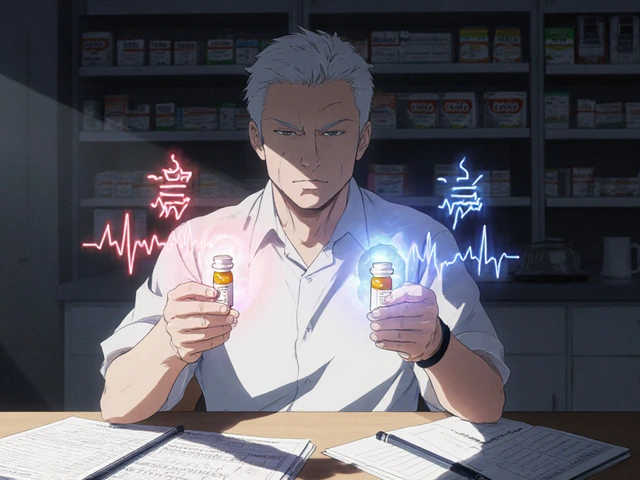
Switching from brand-name drugs to generics seems like a simple win: lower cost, same effect. But what happens after six months? Or two years? For millions of people managing chronic conditions-high blood pressure, diabetes, epilepsy, or heart disease-the story isn’t always that straightforward.
Why the Switch Feels Safe (But Might Not Be)
The FDA says generics are bioequivalent. That means, in a lab, they deliver the same amount of active ingredient into your bloodstream as the brand-name version, within a narrow range (80% to 125% of the original). On paper, it’s a perfect match. And for many people, it works fine. Statins, like atorvastatin or rosuvastatin, are a prime example. Studies show people stick with generic statins more often because they cost $4 instead of $400 a month. That higher adherence leads to fewer heart attacks and strokes over time. But bioequivalence doesn’t guarantee long-term clinical equivalence. The tests that prove equivalence last 2 to 4 weeks. Chronic conditions require treatment for decades. That’s where things get murky.The Hidden Risks: Adverse Events and Changing Pills
A 2017 Canadian study tracked patients switching to generic versions of blood pressure meds like losartan and valsartan. In the first month after the switch, adverse events-like dizziness, fainting, or spikes in blood pressure-rose by 8% to 14%. And those higher rates didn’t fade. They stuck around for the full year. Another red flag? Pill appearance. If your generic pill changes color, shape, or size-even if it’s the same drug from the same manufacturer-you’re more likely to get confused. A 2020 University of Pittsburgh study found 61% of patients worried when their pill looked different. Nearly a quarter of them cut back on doses or skipped pills because they weren’t sure it was the right medicine. For people with epilepsy, this isn’t just inconvenient-it’s dangerous. A 2013 study in JAMA Internal Medicine showed that switching between different generic versions of antiepileptic drugs reduced treatment persistence by 35% over 12 months. That means more seizures, more ER visits, more hospitalizations.Not All Generics Are Created Equal
Here’s something most patients don’t know: the same generic drug can be made in different countries, by different companies, and with different quality controls. A 2021 study from Ohio State University found that generics made in India had 27% more severe adverse events-including hospitalizations and deaths-than the same drugs made in the U.S. The difference wasn’t in the active ingredient. It was in the fillers, the coating, the manufacturing environment. Even older generics-those on the market for five years or more-showed higher risks. Why? Because manufacturers sometimes change suppliers or processes to cut costs. And those changes don’t always get flagged by regulators.
When Generics Cost More in the Long Run
It sounds counterintuitive, but switching to generics doesn’t always save money. A 2015 review in PharmacoEconomics found that in 64% of cases, total healthcare costs went up after switching. Why? Because more people ended up in the hospital. More people needed emergency care. More people had to switch back to brand-name drugs. Medication adherence is the key. People who take their meds consistently have fewer complications, fewer doctor visits, and lower overall costs-even if the drug itself is pricier. A 2011 Health Affairs study proved it: patients who paid more for their brand-name meds were less likely to end up in the hospital than those who switched to cheaper generics but stopped taking them.What You Can Do to Protect Your Health
If you’re on a chronic medication and your pharmacy switches you to a generic, here’s what to do:- Ask your pharmacist: Which manufacturer makes this version? Write it down. Don’t assume all generics are the same.
- Don’t let your pill change without warning. If the color, shape, or size changes, ask why. If you feel different, don’t ignore it.
- Track your symptoms. Keep a simple log: energy levels, heart rate, blood pressure readings, mood, seizures. Compare before and after the switch.
- Ask your doctor to lock in one generic manufacturer. If you’re on a narrow therapeutic index drug-like warfarin, levothyroxine, or seizure meds-stick with one brand. Switching between manufacturers increases your risk of complications by 40%.
- Push back on automatic switches. Many pharmacy benefit managers (PBMs) force switches to cut costs. You have the right to request a brand or a specific generic. Ask your doctor to write “Dispense as Written” or “Do Not Substitute” on the prescription.
What the System Needs to Fix
The current system is built for short-term savings, not long-term health. Regulators approve generics based on 4-week studies. But people take these drugs for 20, 30, even 50 years. That’s a massive blind spot. The FDA is starting to catch up. In 2023, they began requiring 36 months of stability data for generics used in chronic conditions. That’s a step forward. The European Union already requires 24 months of safety data for generics used in long-term therapy. But until we start tracking real-world outcomes over years-not just blood levels over weeks-we’re guessing. And for people with chronic illness, guessing isn’t safe.
Real Stories: The Good, the Bad, and the Confusing
One patient on PatientsLikeMe, ‘HeartWarrior42,’ switched to generic metoprolol succinate. Over 18 months, their heart rhythm got worse. They had two hospitalizations for arrhythmia. When they switched back to the brand, their heart stabilized. No one could explain why-the generic met the FDA’s bioequivalence standards. But the body knew the difference. Another patient, ‘SeniorHealth456,’ has been on generic statins for five years. Their cholesterol is steady. They pay $4 a month. They feel fine. Their story is just as real. There’s no one-size-fits-all answer. For some, generics are a lifeline. For others, they’re a risk. The difference often comes down to the drug, the manufacturer, and how closely you’re monitored.Bottom Line: Stay Informed, Stay Involved
Generics aren’t the enemy. They’re essential for keeping healthcare affordable. But treating them as identical is dangerous. Long-term health after switching depends on consistency, awareness, and communication. Your doctor can’t manage your health if they don’t know what you’re taking. Your pharmacist can’t help you if you don’t ask questions. And you can’t protect yourself if you don’t pay attention to how you feel after a switch. Don’t assume. Don’t accept. Don’t stay silent. If you’re on a chronic medication and your pill changes, speak up. Track your symptoms. Ask for records. Demand stability. Your health isn’t a cost-saving metric. It’s your life.Are generic medications as safe as brand-name drugs in the long term?
For many people, yes. But not always. While most generics work just as well as brand-name drugs, long-term safety isn’t guaranteed. Bioequivalence tests only measure short-term blood levels, not how your body responds over years. Some patients, especially those on narrow therapeutic index drugs like epilepsy or thyroid medications, report worsening symptoms after switching. Manufacturing differences, changes in pill appearance, and multiple switches between manufacturers can all impact long-term outcomes.
Why do some people feel worse after switching to a generic?
It’s not always the active ingredient. Differences in fillers, coatings, or manufacturing processes can affect how the drug is absorbed or how your body reacts. Even small changes in pill size or color can cause confusion, leading to missed doses. For people with chronic conditions, these small changes can add up over time-leading to increased symptoms, hospital visits, or loss of disease control. Some patients report feeling “off” even when lab results look normal.
Can I ask my doctor to keep me on a specific generic manufacturer?
Yes. You have the right to request a specific generic manufacturer or to prevent substitution. Ask your doctor to write “Dispense as Written” or “Do Not Substitute” on your prescription. This is especially important for drugs with a narrow therapeutic index, like warfarin, levothyroxine, or seizure medications. Sticking with one manufacturer reduces the risk of unexpected side effects or loss of control over your condition.
How do I know if my generic medication was switched?
Check the pill’s appearance-color, shape, size, and imprint code. If it looks different from your last refill, it’s likely a different manufacturer. You can also ask your pharmacist for the name of the manufacturer. Most pharmacies list this on the label. If you’re unsure, call your pharmacy and ask: “Was this the same manufacturer as last time?” Keep a record of each manufacturer you receive.
Should I avoid generics altogether to stay safe?
No. Generics are safe and effective for most people and are critical for keeping healthcare affordable. The goal isn’t to avoid them-it’s to use them wisely. For many drugs, like statins or blood pressure meds, generics work just as well and improve adherence because they’re cheaper. The key is consistency: stick with one manufacturer, monitor how you feel, and speak up if something changes. Don’t let cost savings come at the price of your health.



